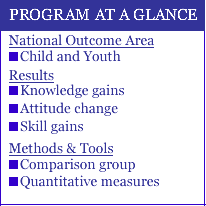|
 |
|
|
|
|
|
|
|
|
|
|
|
|
|
|
|
|
Methods
& Tools |
|
|
|
 |
A
pre- and posttest survey method was used to determine if the above
objectives were met. The surveys were piloted with a small group of
youth and a Spanish translation was also used. Surveys were administered
in class to three different groups: students in 4th-6th grades, students
in 7th and 8th grades, and teen leaders who assisted in implementing
the program. Depending on the age of the child, cultural needs, and
whether it was a pre- or post-test, the survey contained between 32
and 65 items. Objectives 1, 2, & 3 were related to all three groups
of youth. Objective 4 focused only on the teen leaders who assisted
in implementing the program. |
|
|
|
|
|
|
Objective
1: |
Items
related to this objective included: communication about sex (1 or
3 questions), ability to recognize and handle pressures (3 or 4 questions),
reasons for abstaining from sexual intercourse (7-9 questions). |
|
|
|
|
|
|
|
|
|
|
|
|
|
|
|
|
|
|
|
|
Objective
2: |
Items
related to this objective included: personal values about sexual behavior
(5 or 6 questions), values about sexual behavior held by others that
were important to the participant (3 questions). |
|
|
|
|
|
|
|
|
|
|
|
|
|
|
|
|
|
|
|
|
Objective
3: |
Items
related to this objective included: ability to recognize and handle
pressures (3 questions), rights in social relationships (3-5 questions),
ability to avoid problems associated with sexual involvement (2-3
questions), likelihood of abstaining from sexual involvement (1 question). |
|
|
|
|
|
|
|
|
|
|
|
|
|
|
|
|
|
|
|
|
Objective
4: |
Items
related to this objective included 5 questions focusing on confidence
and comfort as a teen leader. |
|
|
|
|
|
|
|
|
|
|
|
|
|
|
|
|
|
|
Analysis |
|
|
|
|
|
|
|
 |
Comparisons
of pre- and post-data were done within sites. Analysis was done by
grade and gender for measures of knowledge, attitude, intention and
skills. |
|
|
|
|
|
 |
In
the first two years, delayed treatment groups were also used as comparisons.
In addition, in one county, follow-up data were collected at the end
of year 5 from students in grades 9 through 12. About half had participated
in the program at some point, the other half had no exposure. Comparison
of knowledge, attitudes and skills were done for these two groups. |
|
|
|
|
|
|
|
|
|
|
|
|
|
|
Results |
|
|
|
|
|
|
|
|
Overall:
|
|
|
|
|
|
|
|
In
comparing treatment and comparison groups, in general (collapsing
across sites and years), "perceived ability to postpone"
(Objective 3) nearly always increased significantly from pretest to
posttest, with the treatment groups scoring better than the control
groups. Additionally, "recognizing risks" (Objective 1)
nearly always increased significantly, while "values" (Objective
2) and "recognizing pressures" (Objective 1) showed a marginally
significant increase. In general, the program seemed to have created
a greater impact on females than on males. |
|
|
|
|
|
|
|
|
|
|
|
|
Comparison
analysis:
|
|
|
|
|
|
In
a five-year follow-up, t-test comparison of participants and non-participants
revealed that the program seemed to have a lasting impact. For example,
participants scored more positively than non-participants on "values"
(Objective 2), "understanding rights in social relationships"
(Objectives 1 and 3) and "likelihood of abstaining" (Objective
3). |
|
|
|
|
|
|
|
|
|
|
|
|
|
Objective
1: |
Comparisons
of pre- and post-data within sites revealed a significant increase
in participants' ability to recognize and handle pressures to have
sex and their understanding of their rights to postpone sex in a social
relationship. Additionally, fewer participants reported that they
had "no one" to go to when they have questions about sex;
in other words, participants were more likely to talk to someone when
they have questions about sex after the program. |
|
|
|
|
|
|
|
|
|
|
|
|
|
|
|
|
|
|
|
|
Objective
2: |
Comparisons
of pre- and post-data within sites revealed a marginally statistically
significant increase in personal values about sexual behavior. |
|
|
|
|
|
|
|
|
|
|
|
|
|
|
|
|
|
|
|
|
Objective
3: |
Comparisons
of pre- and post-data within sites revealed a significant increase
in participants' ability to recognize and handle pressures to have
sex, understanding of their rights to postpone sex in a social relationship,
and feeling more confident about their ability to recognize and prevent
risks associated with sexual involvement. Participants also reported
that they intended to abstain from sexual involvement until they were
older. |
|
|
|
|
|
|
|
|
|
|
|
|
|
|
|
|
|
|
|
|
Objective
4: |
Both
males and females reported very positive experiences as teen leaders;
in other words, they felt confident in their abilities and were comfortable
with their roles. Responses to the open-ended question, "What
are you hoping to gain from your experience as a PSI teen leader?"
fell into two broad groups: a desire to help others and a desire to
learn the skills they were trained to teach their younger counterparts.
|
|
|
|
|
|
|
|
|
|
|
|
|
|
|
|
|
|

